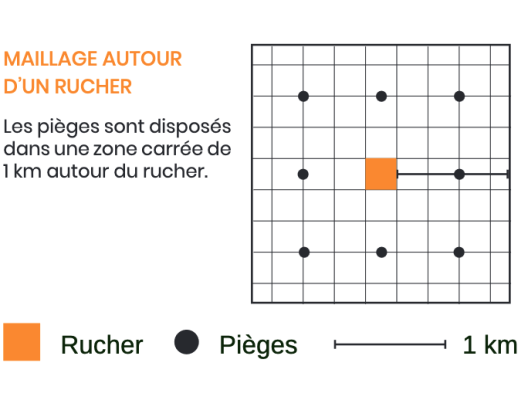Spring trapping is based on the life cycle of the Asian hornet. At this time, the founding queens emerge from their winter lethargy to found their first nest, known as a primary nest.
This is undoubtedly the Asian hornet’s only moment of “fragility”, and it’s vital to take advantage of it to take effective action.
In France the plan national de lutte contre le frelon asiatique (National plan to fight against asian hornet) establishes an organization and also somme recommandations to set up this trapping.
Clean trapping above all
Before going into how to trap, it’s important to state here the importance of selectivity alongside efficiency: Spring trapping must respect biodiversitý and use the right traps. If your trap catches other insects stop trapping or review your approach.
A matter of numbers
Keep record of what you trap
A second preliminary consideration to fully assimilate what follows:
Spring trapping is less obvious than summer trapping, where you fill a trap in 2 days. It’s important to understand that a hornet’s nest can produce ~100 foundresses. Perhaps 10 will be born in the spring.
These 10 are spread over a territory that might be 300 hectares, and the founder must find a trap there that is 0.50 meters on each side, like looking for a needle in a haystack.
It wants to say that it is necessary baits, often renew and well choose its locations: if possible there where one sees flowers and pollinators, bees or others. If you trap 15 foundresses in your spring, that’s fine, but don’t expect much more!
Reporting Asian hornet nests is crucial for monitoring their spread and impact. Depending on your location, specific methods for reporting sightings are available. Stay informed and contribute to environmental protection by learning more about Asian hornet reporting Counting is important: report your nests!
A third consideration is to follow the national recommendation to trace your catch. Be methodical in monitoring your traps and keep a record of your catches on this sheet.
Now that these three prerequisites – being selective, precise and methodical in your trapping – are in place, we can move on to the methodology that follows.
General information on spring trapping
Here’s a brief summary of the current state of knowledge on spring trapping. These instructions are taken from official documents at the current state of knowledge (early 2024).
For a maximum period of 2 months, from early February to late May. Start trapping according to the local climate, after the last frosts when temperatures reach values above 12°C. Explore the Flight Index map, revealing average hourly temperatures across departments over 5 days. Discover why trapping becomes crucial above 10°C and investigate departments highlighted in green for optimal conditions in our article Asian Hornet founding Queens Flight Index.
In spring, an appropriate strategy is needed to attract the foundresses. In particular, the bait must be easy for the foundress to detect.
Baits vary, but the most widely used to date is 1/3 beer 1/3 syrup 1/3 wine, changed every week.
Physical selection traps such as creel traps, fitted with entrance cones, should be used to retain the foundresses and workers, while allowing as many non-target species as possible to escape. The entrance orifice must be adapted to the size of the Asian hornet, to exclude larger insects (e.g. European hornet).
Traps must be primed and maintained in operation.
In pitfall traps, live hornets secrete alarm pheromones that attract other hornets. It is therefore important to encourage and maintain this priming effect:
- Do not empty the traps for a month.
- Add sweet bait every 7 days.
A regular grid of traps is needed around the apiary to be protected: 1 to 2 traps per apiary and up to 10 traps distributed within a 500 m radius of the apiary. Traps must be spaced regularly. They should be monitored regularly, and trapped insects recorded once a week. Note the presence of nests in the previous year to target areas for spring trapping.

How to spring-trap with Ornetin
In addition to the general recommendations above, we recommend the following practices to Ornetin users:
To the best of our knowledge, for trapping foundresses exclusively, we recommend using a liquid bait to produce a strong-smelling substance. Typically 1/3 beer, 1/3 feed syrup, 1/3 wine.
Pour the bait into the bottom of the jar, systematically adding a stopper of grass or straw to prevent drowning.
Then place Ornetin at a slight angle in the chosen location (woodpile, lean-to, garden shed…). A vertical position is not recommended.
To increase trapping efficiency, we recommend covering the trap with a tarpaulin, which has two advantages: it concentrates odors and prevents overheating (e.g. tarpaulin used to protect wood piles).
Monitor traps once a week.
Keep learning
The above advice has evolved over the years. Note that not so long ago there was a debate about whether or not spring trapping was appropriate. It seems that this controversy is now behind us.
Because of the nature of the invasion, France is at the forefront of the fight against the Hornet, and all these experiences benefit and will benefit all those who are or will eventually be confronted with it.
Capitalizing on and disseminating best practices is also an essential weapon in this fight. Learn more about trapping and establishing Asian hornet queens with scientific insights in our informative series Simplifying Science: Series on Asian Hornet Queen Settlement and Trapping
If you have observed and verified practices that optimize trapping, don’t hesitate to let us know so that we can share them as widely as possible with all users.
What is your experience in the field? Write to us on the CONTACT form
